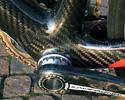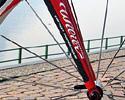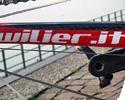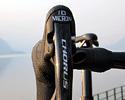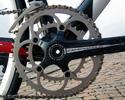
Recently on Cyclingnews.com |
On test: Wilier Triestina Izoard, May 27, 2008
Lower cost carbon offering from Wilier Triestina
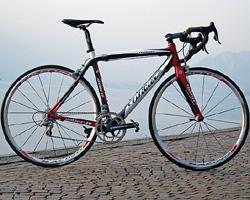
|
Wilier Triestina's Cento and Le Roi are premium-level workhorses for the Lampre squad but their correspondingly premium prices might not suit everyone's palate. Gregor Brown embarks on his own giro d'Italia on Wilier's mid-range Izoard to see if this more economical carbon offering can still pass muster.
Wilier Triestina's revamped Izoard sits third-tier in the lineup but you'd hardly guess just by looking at it. Thanks to a more economical carbon fiber blend, Wilier prices the Izoard frameset at US$1,999.99, making it over US$1000 less expensive than the Le Roi and more than US$2000 cheaper than the top-end Cento. Complete US-spec bikes with Shimano Ultegra and Mavic Ksyrium Equipe clinchers can be had for just over US$3,000.
Even so, claimed weight for the frame and matching monocoque carbon fork is still a very reasonable 1150g and 360g, respectively, putting it just 160g over the Le Roi package and 220g over the Cento. When built with a sensible mix of Campagnolo Chorus, Fulcrum Racing 3 wheels and a Ritchey cockpit, total weight for our test sample without pedals is still a very race-worthy 8.1kg (17.6lb).
Off to the Italian countryside
The Izoard's carbon chassis provided the expected smooth and comfortable ride and made easy work of rough Italian roads. Moreover, even bigger jolts were well muffled with no hard repercussions felt in the arms and legs. Sitting in the saddle, the bike hums along nicely on both flat ground and uphill and swallows up distance with nary a complaint.
Jumping out of the saddle, though, seemed to reveal the Izoard's softer construction as it lacked some of the spring of its bigger brothers even under the moderate 1.8m, 71kg (5' 11", 157lb) test load. Sprints and standing surges heading uphill didn't return the usual instant response of acceleration we've become accustomed to with stiffer steeds and the overall feel was a tad sluggish when really putting the power down. Bear in mind, the Izoard is far from being a soft sidewalk cruiser but those looking for an ultra-responsive rocket ship might be a bit disappointed.
For those actively seeking that slightly more relaxed feel, though, the Izoard's handling traits and riding position should be well suited. As compared to the racier Le Roi and Cento, the Izoard boasts a taller head tube and slacker angles for a more heads-up posture (if you want it, that is; one could easily remove a bunch of headset spacers for a lower bar height) and more stable feel. Even so, the bike was still zippy on the descents and quick out of switchbacks.
The equipment
The included Fulcrum Racing3 clinchers are a touch on the heavy side for a full-blown race wheelset (claimed weight is 1605g without skewers) but their solid build handled well and presented no problems during the test period. They were also perfectly manageable even on particularly windy days in spite of the deeply bladed stainless steel spokes, making for a good all-around set of hoops if you can only have one.
Likewise, Campagnolo's Chorus group performed flawlessly as expected (and looked good doing it) but the stock gearing left much to be desired. We normally don't have any issues with compact cranksets as long as their 50T large chainring is paired with an 11T out back (yielding a gear ratio that is actually taller than a common 53-12T).
However, Wilier Triestina sent our test bike with an unforgivably casual 13-26T that found us spinning way too fast on any sort of downhill or sprint. The all-steel cogs also made our reasonably light wheelset and legitimately feathery Vittoria Diamante Pro tire combo a 2.8kg (6.2lb) boat anchor. While this setup might be suitable for more leisurely jaunts in the park, any serious rider with a reasonable amount of fitness will almost certainly want to swap out the cassette for something with a more appropriate top end.
Lastly, the shape of our Selle Italia SLK Gel Flow test saddle suited our anatomy well enough but the supple leather cover seemed a little too sticky. Instead of just sliding into the right position after rising to stretch the legs, we had to unweight the saddle and re-position. Granted, this is a small issue that could disappear after the saddle is broken in but it's something to keep in mind.
The final score
The Izoard looks the part of a pure racing steed but it delivers a tamer feel and more relaxed position and handling than its sharper-toothed stablemates. Those looking for a fast yet comfortable ride with an Italian nameplate and relatively economical price tag will likely be well satisfied but most racers will most likely want something a little edgier.
Price: US$4,600 (as tested); US$3,899.99 (with Campagnolo Centaur and
Fulcrum Racing3 wheels); US$3,099.99 (with Shimano Ultegra and Mavic Ksyrium
Equipe wheels); US$1,999.99 (frame and fork)
Weight: 8.1kg (17.6lb) as tested, without pedals
Pros: The same handling manners as the Le Roi and Cento, Wilier cachet
at a more attainable cost of entry
Cons: Cheaper fiber blend is noticeably more sluggish, some paint imperfections,
heavy wheels, top-end gearing is far too low
Cyclingnews rating: ![]()
For a thumbnail gallery of these images, click here
Images by Gregor Brown / Cyclingnews.com
- The 2008 Wilier Triestina Izoard offers a lower cost alternative to the Le Roi and Cento.
- The Izoard allows riders to add a Wilier to their stable without breaking the bank too badly.
- The Izoard achieves its lower price point by using a more economical carbon fiber blend.
- The top tube flows nicely into the seat stays (as is seemingly the current fashion).
- Slightly curved seat stays add a touch of cushion to the rear end.
- The Euro-inspired paint job leaves plenty of carbon fiber weave to see.
- The bottom bracket section appears stout enough but serious racers might want more frame stiffness.
- The thin seat stays provide a noticeable amount of bump-eating flex.
- Wilier opts for wishbone-style stays for the Izoard.
- The front of the Izoard is fitted with a matching full-carbon fork claimed to weigh a competitive 360g.
- The integrated-style headset makes for a smooth transition between the frame and fork.
- Just in case you can't remember the URL for Wilier's web site, the company kindly plasters it in big letters on the chain stay.
- Campagnolo Chorus Ergopower levers provided the usual exemplary performance.
- The matching Chorus rear derailleur worked perfectly during the test period.
- The Chorus CT crankset provided plenty of gears for scaling veritable walls.
- Campagnolo's newest front derailleur designs can be used for both standard and compact cranksets.
- Campagnolo's D-Skeleton brake design uses a dual-pivot front brake…
- …and a single-pivot rear for lighter weight and better overall modulation.
- The Fulcrum Racing3 clincher wheelset isn't the lightest around but worked well nonetheless.
- The aluminum rims are milled in between the spoke holes to shave weight.
- Radially-laced straight-pull bladed stainless steel spokes are used up front…
- …while the rear employs Fulcrum's trademark two-to-one lacing pattern for more even spoke tension.
- The Ritchey Pro Logic Road handlebars offer a good shape and competitive weight at a palatable price.
- The Ritchey WCS 4Axis stem may not have the sex appeal of carbon but is likely lighter and almost as rigid.
- The Ritchey Pro Carbon seatpost performed its duty without fail.
- A red Selle Italia SLK Gel Flow saddle adds a bit of visual flair. The leather cover was a tad hard to slide around on but might break in with use.
Full specification: Wilier Triestina Izoard
|
Frame: Wilier Triestina Izoard |
Shift levers: Campagnolo Chorus Ergopower QS 10s |

